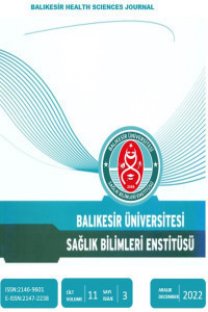Akut Pankreatitli Hastalarda Yaş Şok İndeksinin Kritik Hasta Ayrımındaki Etkinliği
The Effectiveness of the Age Shock Index in Critical Patient Discrimination in Patients with Acute Pancreatitis
___
- Neoptolemos, J. P., Raraty, M., Finch, M., & Sutton, R. (1998). Acute pancreatitis: the substantial human and financial costs. Gut, 42(6), 886-891.
- Mann, D. V., Hershman, M. J., Hittinger, R., & Glazer, G. (1994). Multicentre audit of death from acute pancreatitis. Journal of British Surgery, 81(6), 890- 893. https://doi.org/10.1002/bjs.1800810632
- Appelros, S., Lindgren, S., & Borgström, A. (2001). Short and long term outcome of severe acute pancreatitis. European Journal of Surgery, 167(4), 281-286. https://doi.org/10.1080/110241501300091462
- Banks, P. A., Bollen, T. L., Dervenis, C., Gooszen, H. G., Johnson, C. D., Sarr, M. G., ... & Vege, S. S. (2013). Classification of acute pancreatitis—2012: revision of the Atlanta classification and definitions by international consensus. Gut, 62(1), 102-111. http://dx.doi.org/10.1136/gutjnl-2012-302779
- Janisch, N. H., & Gardner, T. B. (2016). Advances in management of acute pancreatitis. Gastroenterol Clin North Am. 2016 Mar;45(1):1-8. https://doi.org/10.1016/j.gtc.2015.10.004
- Rassameehiran, S., Teerakanok, J., Suchartlikitwong, S., & Nugent, K. (2017). Utility of the Shock Index for Risk Stratification in Patients with Acute Upper Gastrointestinal Bleeding. Southern medical journal, 110(11), 738-743.Latner, J. D., & Stefano, E. C. (2016). Obesity Stigmatization and the Importance of the Research of AJ Stunkard. Current obesity reports, 5(1), 121-125. https://doi.org/10.14423/SMJ.0000000000000729
- Otero R., Nguyen B. Şoktaki hastaya yaklaşım. Judith Tintinalli, et al. [çev.] Cem Ertan. Acil tıp Kapsamlı Bir Çalışma klavuzu. İstanbul : Nobel Tıp Kitapevi, 2013;65-172.
- Cetinkaya, H. B., & Gunes, H. (2021). Use of Shock Index and Lactate to Predict Mortality in Acute Heart Failure Patients in Emergency Department. Journal of the College of Physicians and Surgeons--Pakistan: JCPSP, 31(3), 262-266.
- Sankaran, P., Kamath, A. V., Tariq, S. M., Ruffell, H., Smith, A. C., Prentice, P., ... & Myint, P. K. (2011). Are shock index and adjusted shock index useful in predicting mortality and length of stay in communityacquired pneumonia?. European journal of internal medicine, 22(3), 282-285. https://doi.org/10.1016/j.ejim.2010.12.009
- Mutschler, M., Nienaber, U., Münzberg, M., Wölfl, C., Schoechl, H., Paffrath, T., ... & Maegele, M. (2013). The Shock Index revisited–a fast guide to transfusion requirement? A retrospective analysis on 21,853 patients derived from the TraumaRegister DGU®. Critical Care, 17(4), 1-9. https://doi.org/10.1186/cc12851
- Torabi, M., Moeinaddini, S., Mirafzal, A., Rastegari, A., & Sadeghkhani, N. (2016). Shock index, modified shock index, and age shock index for prediction of mortality in Emergency Severity Index level 3. The American journal of emergency medicine, 34(11), 2079-2083. https://doi.org/10.1016/j.ajem.2016.07.017
- Yu, T., Tian, C., Song, J., He, D., Sun, Z., & Sun, Z. (2017). Age shock index is superior to shock index and modified shock index for predicting long-term prognosis in acute myocardial infarction. Shock: Injury, Inflammation, and Sepsis: Laboratory and Clinical Approaches, 48(5), 545-550. https://doi.org/10.1097/SHK.0000000000000892
- Phillip, V., Steiner, J. M., & Algül, H. (2014). Early phase of acute pancreatitis: assessment and management. World journal of gastrointestinal pathophysiology, 5(3), 158. https://doi.org/10.4291/wjgp.v5.i3.158
- Kim, S. Y., Hong, K. J., Do Shin, S., Ro, Y. S., Ahn, K. O., Kim, Y. J., & Lee, E. J. (2016). Validation of the shock index, modified shock index, and age shock index for predicting mortality of geriatric trauma patients in emergency departments. Journal of Korean medical science, 31(12), 2026-2032. https://doi.org/10.3346/jkms.2016.31.12.2026
- ISSN: 2146-9601
- Yayın Aralığı: Yılda 3 Sayı
- Yayıncı: BALIKESİR ÜNİVERSİTESİ
Hemşirelik Öğrencileri İle Bir Metafor Analizi: Onkoloji Hemşiresi Olmak
Hemşirelik Öğrenci Deneyimlerini Dijital Hikaye İle Anlama
Aydanur AYDIN, Ayla GÜRSOY, Zeynep TATLI
Aydıntepe’de yaşayan bireylerde göz kuruluğu sıklığının ve risk faktörlerinin incelenmesi
Reva BALCI AKPINAR, Arzu ÇİMEN
Fadime ÜSTÜNER TOP, Hasan Hüseyin ÇAM, Nilüfer İLYAS
Hastane Çalışanlarında Üstünlük Vehmi-İş Tatmini İlişkisi
COVID-19 Enfeksiyonu ve D Vitamini Düzeyleri Arasındaki İlişki
Kanser Hastalarında İki Yıllık Subkutan Venöz Port Kateter Deneyimimiz
Down Sendromu Tanılı Olgularda Aile ve Çocuğa Ait Sosyodemografik Özelliklerin Değerlendirilmesi
PKOS Hastalarında Yüksek Kan Basıncı Sıklığı ve Bunun Klinik ve Laboratuvar Parametrelerle İlişkisi
COVID-19 Salgınının Diş Hekimleri Arasında Yarattığı Korku ve Kaygının Değerlendirilmesi
